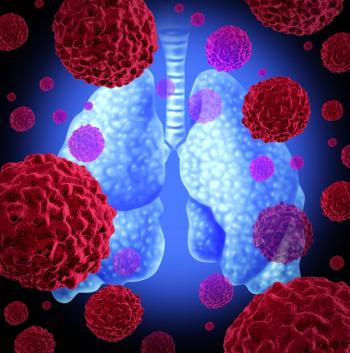
Nivolumab Alone or With Ipilimumab Produced Durable Response in SCLC
Treatment with nivolumab alone and in combination with ipilimumab resulted in durable responses in patients with previously treated small-cell lung cancer.
Treatment with nivolumab alone and in combination with ipilimumab resulted in durable responses in patients with previously treated small-cell lung cancer (SCLC), according to the results of an expansion cohort of the phase I/II CheckMate 032 study (abstract
Results from the initial nonrandomized cohort of the study showed that about one-quarter of patients assigned to combination treatment were still alive at 2 years.
“This result is simply not possible with other types of anticancer therapy in this disease,” said Matthew D. Hellmann, MD, of Memorial Sloan Kettering Cancer Center in New York, who presented the results. “Responses were seen across lines of therapy in both platinum-sensitive and platinum-resistant settings.”
The initial cohort of CheckMate 032 consisted of about 150 patients with recurrent SCLC. Patients were assigned to receive either nivolumab or nivolumab plus ipilimumab. The results showed the efficacy of the combination of nivolumab and ipilimumab.
The objective response rate for the combination was 23%; for nivolumab monotherapy, it was 11%. The median time to response with combination therapy was 2 months, with a median duration of response of 14.2 months. The overall survival for the combination was 20.2 months.
Based on these positive results, an expansion cohort was started to evaluate these drugs in a randomized fashion in patients with SCLC whose disease had progressed after platinum-based therapy.
Patients were randomly assigned 3:2 to nivolumab 3 mg/kg (n = 147) or nivolumab 1 mg/kg plus ipilimumab 3 mg/kg (n = 95). The primary endpoint was objective response rate.
The objective response rate was 12% for nivolumab monotherapy and 21% for the combination. One patient on each arm achieved a complete response. These responses closely mirrored the responses seen in the nonrandomized study, Hellmann noted.
“In both cohorts the response rate was approximately doubled with the combination compared to nivolumab monotherapy,” he said.
Long-term outcomes remain immature for the randomized expansion cohort. For this interim analysis, Hellmann described the 3-month progression-free and overall survival rates. The 3-month progression-free survival rate was 18% for nivolumab and 30% for the combination. The 3-month overall survival rate was 65% for nivolumab monotherapy and 64% for the combination.
Finally, the researchers pooled data from the two cohorts in order to conduct subgroup and safety analyses. In the pooled analysis, the objective response rate was 11% for nivolumab and 22% for nivolumab plus ipilimumab.
“Responses were seen in second line and third line and beyond, including a quarter of patients treated with nivolumab plus ipilimumab in the third line and beyond setting,” Hellmann said.
Responses were seen regardless of platinum sensitivity or programmed death ligand 1 status.
Only 12% of patients assigned monotherapy experienced a grade 3/4 treatment-related adverse event, and only 2% of patients discontinued treatment due to these events. For combination treatment, 37% of patients experienced a grade 3/4 treatment-related adverse event; however, only 10% of patients discontinued treatment due to these events and 78% were resolved with either treatment hold or immunosuppression. There were five treatment-related deaths; four in the combination arm and one in the monotherapy arm.
Hellmann said that future additional analyses will explore quality-of-life outcomes and biomarkers that can be used to predict who will respond to the immunotherapy.
Newsletter
Stay up to date on recent advances in the multidisciplinary approach to cancer.































































































